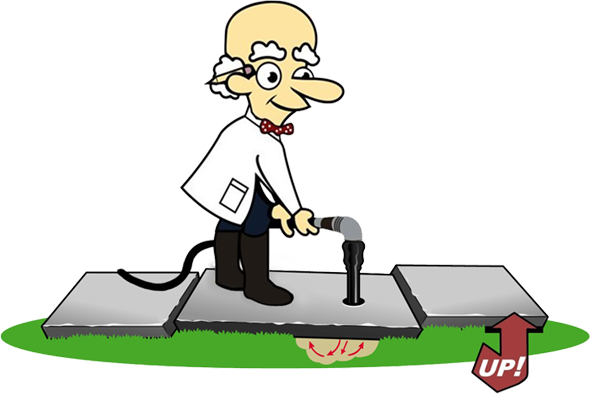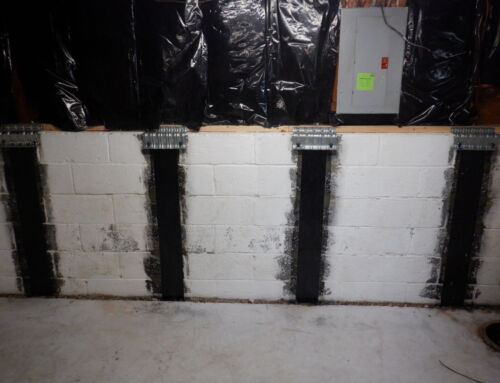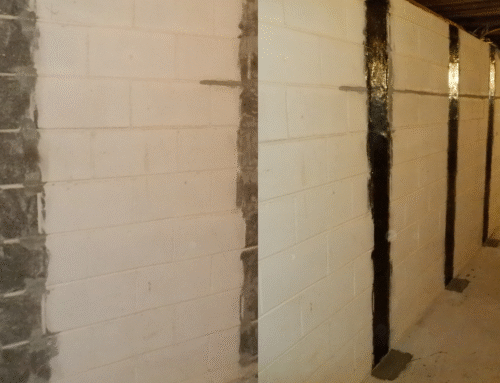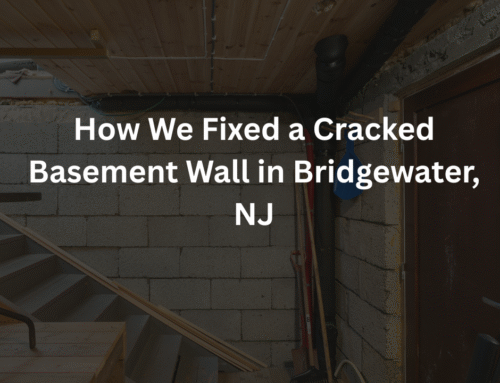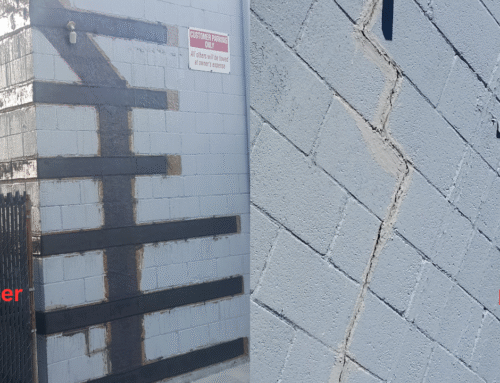IN THIS ARTICLE
Discover all you need to know about Carbon Fiber Foundation Repair and why it might be the best for your Basement Walls.
Basement walls are designed to hold back tons of soil pressure, but over time, cracks, bowing, and settlement can develop. Many homeowners worry about structural damage, water intrusion, and long-term foundation problems. Fortunately, carbon fiber basement wall straps provide a modern, minimally invasive solution to stabilize cracked or slightly bowed walls.
In this article, we’ll walk you through everything you need to know about carbon fiber foundation repair, including what it is, how it works, when it’s appropriate, maintenance tips, costs, and how to find a qualified installer. Our goal is to educate you so you can make informed decisions about your home or business property.
What Are Carbon Fiber Basement Wall Straps?
Carbon fiber basement wall straps are thin, ultra-strong strips of carbon fiber that are bonded directly to interior basement walls using industrial-grade epoxy. Unlike steel, carbon fiber is lightweight, corrosion-resistant, and unaffected by moisture, making it ideal for interior applications where dampness might otherwise compromise other reinforcement materials.
Once installed, the straps are barely noticeable. They sit flush against the wall and can even be painted to match the interior, preserving the appearance of your basement. The straps function by reinforcing the wall in tension, holding it in place against the inward pressure of soil. This prevents small cracks from worsening and bowing from progressing further.
One of the advantages of carbon fiber straps is that they provide high tensile strength without the bulk or disruption of more invasive repairs. Traditional steel reinforcements often require large plates, excavation, or messy construction, but carbon fiber straps provide an elegant solution that works quietly in the background. They are especially effective for walls that have begun to show minor bowing or cracking but are not yet severely compromised.
Key benefits of carbon fiber straps include:
- High tensile strength, resisting inward movement
- Low-profile appearance
- Resistant to moisture, mold, and corrosion
- Quick installation compared to exterior anchor systems
How Carbon Fiber Repairs Work
To understand why carbon fiber straps are effective, it helps to look at the forces acting on a basement wall. Soil surrounding the foundation exerts constant lateral pressure. In colder climates, the wet soil freezes and expands, putting inward pressure on the basement wall. Over time, this pressure can cause walls to bow inward, develop vertical or horizontal cracks, and, in some cases, allow water to seep into the basement. The cracks and bowing may start as minor issues, but if left unchecked, they can lead to more serious structural problems.
Carbon fiber straps work by resisting the inward push of the soil. The straps are applied vertically along the wall and bonded with high-strength epoxy. Once cured, the straps distribute the stress along the wall, preventing localized points of weakness from worsening. This redistribution of load reduces the risk of additional cracks forming and stabilizes the existing wall structure.
It is important to note that carbon fiber straps do not push walls back outward. Their function is preventive and stabilizing, not corrective in terms of realigning severely bowed walls. They stop the progression of movement, holding the wall in its current position and preventing future damage. In many cases, this stabilization is sufficient to maintain both the structural integrity of the home and the usability of the basement.
Also Read: Discover how We Repaired a Cracked Basement Wall in Alexandria Township, New Jersey
When Carbon Fiber Is a Great Choice — And When It’s Not
While carbon fiber straps are highly effective for many basement walls, they are not a solution for every situation. They are most effective for walls with minor bowing or small cracks, generally less than 1.5 to 2 inches of inward movement. Walls that have a history of minor water infiltration or show early signs of structural stress are also excellent candidates.
Carbon fiber straps are not suitable for walls that are severely bowed or leaning, nor are they intended to correct walls that are heaving due to ongoing settlement. In these cases, additional structural reinforcement such as wall anchors, helical tiebacks, or underpinning may be required.
Homeowners should watch for signs that their walls may benefit from carbon fiber stabilization. Interior cracks, slight inward bowing, or evidence of past water damage are indicators that an inspection may be warranted. If caught early, repairs are simpler, less expensive, and far less disruptive. For a real-life example of carbon fiber repair in action, you can review our Carbon fiber wall repair, Bridgewater, NJ case study. This case demonstrates how minor structural issues were addressed before they became serious problems, using minimally invasive methods.
When applied correctly, carbon fiber straps offer a long-lasting, low-disruption solution for stabilizing basement walls while maintaining a clean interior space.
Longevity, Maintenance, and Warranty Considerations
One of the reasons carbon fiber straps are trusted by homeowners and business owners alike is their durability and minimal maintenance. When installed properly, these straps can last for decades. Unlike steel, carbon fiber does not rust or corrode, making it ideal for damp basement environments. Furthermore, carbon fiber itself does not support mold growth, which contributes to a healthier basement environment.
Even though these straps are low-maintenance, it is still wise to periodically inspect your walls. Looking for new cracks or subtle signs of stress every few years ensures that small issues are addressed before they become larger, more expensive problems. Manufacturers often offer warranties ranging from 10 to 25 years, provided that installation follows their specifications. Ensuring that your installer adheres strictly to manufacturer guidelines not only maintains warranty coverage but also maximizes the lifespan and effectiveness of the repair.
Maintenance is simple and non-intrusive. Cleaning walls and checking strap adhesion is typically all that is required. Because the straps are applied to the interior wall surface, homeowners can enjoy peace of mind knowing that their walls are stabilized without ongoing, disruptive maintenance.
Typical Cost Factors and What to Expect
The cost of carbon fiber foundation repair can vary depending on several factors. The size and height of your walls, the number of cracks, and the amount of preparation work required all play a role in determining price. Local labor rates, especially in areas like New Jersey and Eastern Pennsylvania, can also influence the total cost.
Carbon fiber repairs are generally more cost-effective than more invasive options, such as full wall replacement or exterior excavation. While the initial investment may seem significant, the minimal disruption, longevity, and long-term protection they provide often make carbon fiber straps a smart choice.
Each home or business is unique, so it is essential to have a professional evaluate your walls in person. A qualified installer can provide a detailed assessment and quote based on the specific conditions of your basement. Understanding what is included in the cost, such as surface preparation, epoxy, and installation, will help homeowners make informed decisions and avoid unexpected expenses.
How to Choose a Qualified Installer
Selecting the right installer is crucial for ensuring that carbon fiber straps perform as intended. Not all contractors have experience with this specialized material. Look for a professional who has a history of successful installations and can provide references or before-and-after photos from previous projects.
An experienced installer will follow manufacturer specifications for epoxy, strap placement, and spacing, which is essential to maintain warranty coverage and ensure long-term effectiveness. They should also be able to answer questions about maintenance, expected lifespan, and how to monitor your walls over time.
By choosing a knowledgeable professional, homeowners and business owners can have confidence that their basement walls are stabilized properly and that the repair will last for decades without additional intervention.
Case Study
A homeowner in Raritan, NJ, noticed a small crack and slight inward bowing on one of their basement walls. Concerned about the structural integrity of the home, they contacted us for an inspection. After a thorough evaluation, we determined that carbon fiber straps were the ideal solution.
The process began with careful surface preparation, followed by the application of industrial epoxy and vertical bonding of the carbon fiber straps. Optional plates were added at stress points for extra reinforcement. The result was immediate stabilization, with no further inward movement of the wall.
The straps were virtually invisible and paintable, preserving the clean appearance of the basement. The homeowner was able to continue using the space with minimal disruption. You can read the full details of this repair in our Raritan, NJ case study.
When to Call Us for Concrete Settlement Issues in NJ and Eastern PA
Before any repair, check your local building codes. Some municipalities require permits for foundation work or structural modifications. Carbon fiber wall straps are generally interior and low-disruption, but inspections ensure compliance and safety.
At Concrete Chiropractor, we have over 25 years of experience fixing concrete settlement issues, residential and commercial concrete floor repairs, and installing carbon fiber basement wall straps in New Jersey & Eastern Pennsylvania cities. We specialize in stabilizing bowed or cracked walls while minimizing disruption to your home or business, and we are committed to providing clear guidance and professional solutions for foundation concerns.
If you notice cracks or bowing on your walls, we’re happy to inspect your basement and help you understand your options. We’ll evaluate whether carbon fiber straps are the right solution for your walls — no pressure, just professional guidance.
Frequently Asked Questions
What is the main purpose of carbon fiber basement wall straps?
The primary purpose is to stabilize basement walls that have cracks or slight inward bowing. They prevent further movement and crack propagation without major excavation or interior disruption.
Will carbon fiber straps straighten a severely bowed wall?
No. Carbon fiber straps do not push walls back outward. They stabilize walls to prevent additional bowing and damage. For severely bowed walls, additional methods like wall anchors or helical tiebacks may be required.
How long do carbon fiber wall straps last?
With proper installation, carbon fiber straps can last decades. They resist corrosion, moisture, and mold, making them a long-term solution for interior basement stabilization.
- How We Raised a Sunken Concrete Walkway in Sewell, NJ - November 20, 2025
- Carbon Fiber Foundation Repair: All You Need to Know - November 20, 2025
- 5 Common Causes of Concrete Porch Collapse (and How to Prevent It) - November 20, 2025

